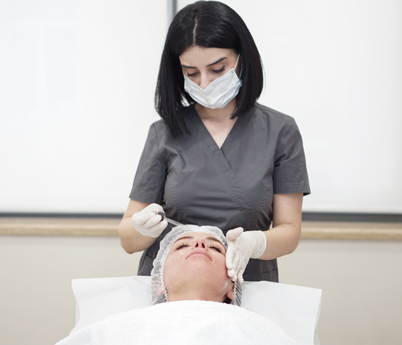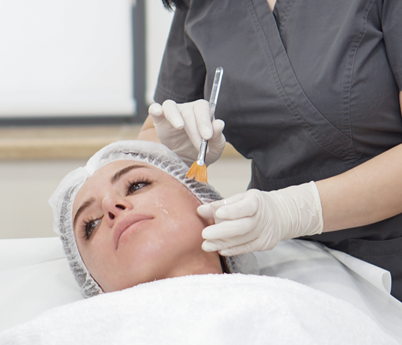 Heratsi Branch
Heratsi Branch
 Heratsi Branch
Heratsi Branch
 Heratsi Branch
Heratsi Branch
There are several kinds of chemical peelings distinguished by the penetration depth into the skin and on the chemical composition.
• Peelings of surface impact
• Peelings of median impact
• Peelings of profound impact
• Peelings for striae (stretch marks)
• Other types of peelings
A separate group includes retinoic peelings – Block-Age, which differ from other types by mechanism of action, multidimensional influence on tissues and by rehabilitation period. These peels are very popular among professionals and patients. They are effective and non-traumatic (ACP; Licorice; Yellou peel – two days).
Perfeitopeel – peeling of chemical and mechanical action is a perfect surface peeling to solve aesthetic problems (improvement of texture, skin relief, refresh-effect). After Perfiotopeel procedure any other procedures (deep hydration, ionization, middle and deep peels, the results of which become more pronounced) can be carried out.
Mindalicpeel – almond peel -surface peeling based on mandelic acid to solve the problems associated with acne, skin aging. Recommended for people with wheatish complexion.
Glycolicpeel – glycolic peels – the most popular surface peeling. Improves skin tightness, its color, elasticity, reduces number of wrinkles.
Piruvicpeel – a new peeling in cosmetology. Effectively combats acne, hyperpigmentation, aging. Depending on the concentration allows to work at a different level.
Salicylicpeel – salicylic peels – a well-known peeling, especially to cosmetologists of previous years, the one that has passed the test of time and continues to help solving many aesthetic problems, easy to hold.
ABR – ABR peeling combines an action of alpha – (fruit) and beta – (salicylic acid), which carry out exfoliation, smooth the surface and regulate the oiliness of the skin, with the active ingredients – vitamins A and C. Thanks to this unique formula, in addition to peeling we get an anti-inflammatory, whitening and rejuvenating effect without too much skin trauma.
Salicylicpeel – salicylic peels – a well-known peeling, especially to cosmetologists of previous years. It has passed the test of time and continues to help solving many aesthetic problems, easy to hold.
Jessnerpeel – Jessner’s solution – a classic peeling on the basis of resorcin, lactic and salicylic acids. Well regulated, gives a quick cosmetic effect.
TCA peel – the most common classic peeling on the basis of trichloroacetic TCA. Allows solving various problems associated with fading, hyperpigmentation, acne.
Phenol peels – eliminate wrinkles, smooth the deep ones, tighten the skin of the periorbital and perioral areas, improving the contour of face oval, to solve problems of stretch marks on the body.
Peelings for striae (stretch marks)
Striapeel -a combined peeling correction of striae (stretch marks). The main task of peeling is an impact on stretch marks. To solve this difficult problem, a complex aesthetic alpha-hydroxyacid, salicylic acid and resorcin is used. As a result, desquamation of epidermis and skin regeneration are enhanced, which leads to a marked cosmetic effect. Striae of any limitations other than “fresh” ones are amenable to correction. After 10-12 sessions their appearance is greatly improved, small stretch marks disappear, deep striae are reduced in size, “gloss” disappears.
Other types of peelings
A separate group of peelings include retinoic peelings – Block-Age, which differ from other types by mechanism of action, multifaceted influence on tissues, the rehabilitation period. These peels are very popular among professionals and patients. Other ACP; Licorice; Yellou peel are non-traumatic and effective.


